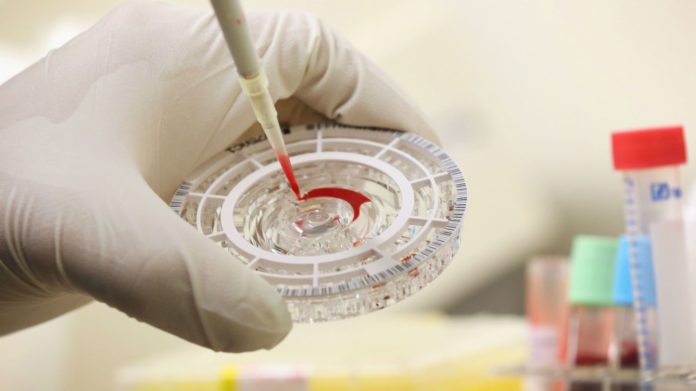
U.S. researchers say their lack of access to Ebola samples is hindering their efforts to understand the deadly virus and plan ahead for new drugs and vaccines.
Much like the flu virus, Ebola mutates – however slightly – as it spreads, and keeping up with those changes is key to stopping new infections and heading off future outbreaks. But according to a report released by Reuters on Wednesday, scientists in the U.S. haven’t been able to obtain Ebola samples in months.
“No one really knows right now what has the virus mutated to or if it has mutated,” Dr. Charles Chiu, a microbiologist and infectious disease expert at the University of California, San Francisco, told Reuters. “We’re not going to be able to determine in advance whether or not it has changed to a form where it might evade diagnostic assays or might render current vaccines or drugs ineffective” without new samples of the virus, he said.
Moving Ebola samples safely from one place to another is complicated, and transport companies have been wary of working with the virus because of growing concerns about a U.S. outbreak. Doctors in Guinea, Liberia and Sierra Leone, where infections have topped 13,500 people, have been slow to hand over samples of Ebola, scientists told Reuters, which means researchers studying the virus elsewhere are not getting the latest specimens.
Ten U.S. disease specialists at eight major research institutions were interviewed for the Reuters report; all ten said they had not been able to get access to new virus samples in recent months.
As Ebola continues to spread across West Africa, it has more chances to change and adapt. Data from the current outbreak — the worst in recorded history — indicate that the virus is mutating much more rapidly than in the past. By late August, scientists had already identified 341 mutations that distinguish the 2014 Ebola virus from previous outbreaks, according to a study published that month in the journal Science. So far, these mutations have not been remarkable; however, as more people are infected, the risk of significant mutations increases, as well.
Mutation scenarios
Although Ebola becoming airborne is the ultimate disease nightmare, scientists say it’s a highly improbable possibility. As a fluid-borne virus that attaches itself to cells lining the circulatory system, Ebola can’t easily change into one that targets the tiny air sacs in the lungs. There is no precedent for such a fundamental switch in transmission mode in any of the viruses that cause serious human disease today, and Ebola has no need to make such a drastic change — it’s already spreading rapidly and infecting thousands of people with it’s current route of transmission.
Another, far more realistic concern is that the virus could become more transmissible by becoming less pathogenic — sickening or killing its victims more slowly — and thereby leaving them more time to infect others. According to Dr. Peter Jahrling, one of the nation’s leading infectious disease specialists and a chief scientist at the National Institute of Allergy and Infectious Diseases, there is evidence that the Ebola virus circulating in West Africa may be more contagious than past strains. Levels of virus found in the blood of Ebola victims — also called the viral load – during the current outbreak are far higher than anything seen before, Dr. Jahrling told Vox. With more virus in patients’ bodies, there is simply a greater probability of spreading the infection to others, he said.
An even greater fear is that the virus will mutate to become harder to detect or more resistant to treatment. Researchers studying the 2014 epidemic have found that the virus is accumulating many mutations in the region of its genome that diagnostic tests use to identify the disease. Too many mutations of this sort could render standard tests inaccurate, making it much more difficult to diagnose Ebola infections and hampering the medical community’s ability to treat and contain the virus. Such changes could also impact vaccine development and therapies for treating the disease.
Ongoing crisis
While Ebola’s ongoing evolution is unlikely to lead to an airborne virus, it is likely to lead to other changes that will affect how we fight this deadly outbreak, which is still spiraling out of control across much of the affected region. International efforts to help stop the outbreak are finally starting to pick up steam, but the virus is still far outpacing the sluggish global response.
Currently, there are six Ebola vaccines at different stages of development — three in the United States, one in Britain, one in Mali and one in Switzerland. If the vaccines are shown to be safe in preliminary trials, they will next be tested on healthcare workers fighting Ebola in West Africa. However, Laurie Garrett, the senior fellow for global health at the Council on Foreign Relations in New York, told Reuters that the drug developers haven’t been able to analyze the latest virus samples to assess for any new mutations. “All the companies working on vaccines, diagnostics and treatments are complaining about lack of access to viral samples,” of Ebola, she said.
The African Governance Initiative (AGI) warned this week that the region could face a shortfall of over 6,000 Ebola beds by December unless more is done; resources and personnel are in short supply, with an estimated 5,000 additional trained health workers needed immediately. According to the group’s recent situation assessment, almost half of the beds currently pledged by the international community have nobody to staff them. And despite signs that cases are beginning to level off in Liberia, AGI’s analysis found that the virus is spreading nine times faster in Sierra Leone than just two months ago.
“The international community badly misjudged the impact of the Ebola epidemic in its first few months,” said AGI chief executive Nick Thompson, “and [they] are compounding that error by failing to act quickly enough now.”
